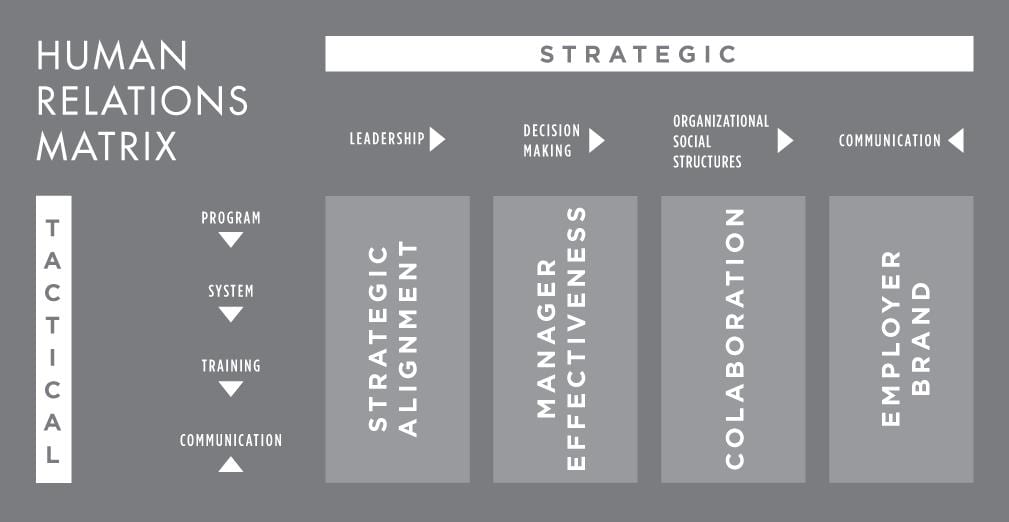A strategic HR framework that makes collaboration actually work
This is a guest post by Jeremy Henderson of Jungle Red Communication.
 Jeremy has worked at such recognizable companies as Salesforce.com, eBay and VeriSign. Jeremy was inspired to found Jungle Red Communication (@Jungle_Red_Comm) after spending years with people who did not know how to be happy and productive in the workplace.
Jeremy has worked at such recognizable companies as Salesforce.com, eBay and VeriSign. Jeremy was inspired to found Jungle Red Communication (@Jungle_Red_Comm) after spending years with people who did not know how to be happy and productive in the workplace.
Jeremy will be speaking about the Human Relations Matrix and how it supports effective enterprise collaboration on the August 6th episode of IBF Live. Sign up for a one-time free guest pass.
All over the world, in every industry and market sector, employers are beginning to realize the impact that collaboration can make on business results. As a matter of fact, according to IBM’s Global CEO Study, “collaborative environment” is one of the top three organizational attributes.
Enter social intranets, which serve an organization fantastically well when aimed at connecting employees, building relationships, discovering hidden projects and skills that can boost productivity and drive revenue. Simple, right? Sure it is. Just talk to any salesperson selling any number of software tools that exist today. The “on-the-ground” truth is very different, though.
Social intranets are failing many of us for a number of reasons. First, we are sold the idea that once you turn it on, it essentially runs itself. Second, we don’t resource and manage social intranets in a manner that allows for effective use of the tool. And third, employees get lost in the thousands of communities that pop up.
So what do we do to solve all of that?
Enter The Human Relations Matrix.

The Human Relations Matrix is an innovative methodology that engages employees at every level with your business strategy and enables them to make the best decisions and focus their talents on what is important. Since the secret to workplace productivity is to holistically align everything a company does – from recruiting and orientation to termination and alumni groups – with the business strategy, you’ll quickly benefit from the resulting strategic alignment, where everyone understands what needs to get done and how to do it.
Once everyone is on the same page, you can then accelerate the achievement of your strategy through collaboration. To do so, you simply must focus on doing collaboration the right way, rather than simply turning on the tool and calling it done. For collaboration to be successful, you’ll want to design a collaboration initiative that includes:
- Program—A program defines what you are going to solve. In relationship to collaboration, your program should be exceptionally clear about the issues that result from poor collaboration or major business silos that keep people from working together effectively. The key to making collaboration work at any organization is having a crystal clear program document that spells out every aspect of what collaboration will do for your business and getting every necessary person to sign off on it before you spend time, money and resources on building and launching a social intranet.
- System—Once you have the program agreed to, then you can design your system of collaboration. Be very clear, collaboration is both an offline and online process. So while we all want to flip the switch and turn the social intranet on, be sure to have your partners in the offline part of the system ready to go when you are. Otherwise, your online system will produce far fewer results. To ensure the social intranet is a success, be sure to make thoughtful decisions up front, such as:
- How does our social intranet support achievement of the strategy?
- How will we resolve conflicts that arise when we get different direction on what we should be doing with our social intranet?
- Will we allow for anyone to establish open and private groups?
- What do we do when we have too many or similar groups?
- What happens when we have less than appealing posts by employees?
- How will the social intranet be resourced, paid for and governed?
- Training—More often than not, employees will quickly understand how a social intranet works. We wouldn’t think that there is a lot to teach when it comes to using the technology, and we’d be right. The issues employees encounter often revolve around content. They either don’t know how to find content or are afraid to post something that could get them in hot water – especially those who work in the HR department. As such, training becomes a necessary part of the process. And because the social intranet is only one part of the overall collaboration system, let alone the larger collaboration program, training employees on what is acceptable, how to use it, and what to do if there is an issue becomes incredibly important to the overall success of collaboration at your company.
- Communication—Communication is the lifeblood of any organization and a social intranet serves as the shot that makes it all pump faster. To make a social intranet highly successful, it has to be a grassroots effort. Get those with the most influence on it first and have them tell the story of what it has done for them, and can do for others. Clearly, if all of the cool kids are doing it, then it must be something anyone in the organization can embrace.
Social intranets can help transform any business from ordinary and under-producing to one where employees love to work and that exceeds business expectations. The trick is to simply build a holistic collaboration initiative that is supported by a robust and well-designed social intranet. When we do this well, the result is always a happy, healthy, productive workplace that sees revenues rise, expenses fall, and profits that any organization would be jealous of.
I’ll be speaking about the Human Relations Matrix and how it supports effective collaboration on the August 6th episode of IBF Live. Sign up for a one-time free guest pass to hear more and see a live tour of a social intranet in action.
Categorised in: Collaboration
